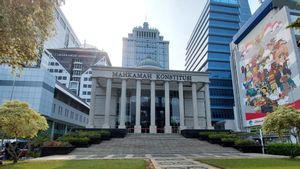Deputy Governor of West Sumatra Audy Joinaldy said the stunting prevalence rate in the province in 2022 was 25.2 percent, an increase of 1.9 percent compared to 2021 which reached 23.3 percent.
"The increase in stunting prevalence rates must be a serious concern for all parties. While it is still the beginning of the year, we are strengthening coordination to find solutions so that the numbers can go back down," said Audy Joinaldy as quoted by Antara, Sunday, January 29.
Based on data from the Indonesian Nutrition Status Survey (SSGI), West Sumatra's stunting rate in 2021 is 23.3 percent. However, in 2022 it rose 1.9 percent to 25.2 percent.
The Deputy Governor said that one of the efforts that must be done immediately is local government intervention in reducing stunting, including the provision of blood-added tablets, especially for pregnant women and increasing animal protein consumption in children throughout West Sumatra.
"This is our big homework together this year. We will also strengthen coordination and communication, especially with doctors, midwives, health centers that will be the focus of our strength in the district and city," he said.
On the other hand, the Deputy Governor highlighted data from SSGI which he said raised several questions, because from the same data source, 13 of the 19 regencies and cities in West Sumatra were said to have succeeded in reducing the stunting rate.
Even the prevalence of stunting in Sawahlunto City has touched 13.7 percent and reached the national stunting prevalence target of 14 percent.
Another question is West Pasaman Regency, which previously received an award and was the national pilot as the most progressive district in the stunting reduction program, it turns out that in the data it has increased the stunting prevalence rate by 11.5 percent.
Regarding SSGI data, West Sumatra SSGI Chairman Gusnaidi stated that the survey was conducted by taking 1,123 census blocks in 19 districts and cities.
In each block there are 10 households recorded. The number of samples, he said, has almost tripled compared to 2021.
"The number has been statistically confirmed to meet the requirements to describe the conditions. The margin of error is below 5 percent and the relative standard error is a maximum of 25 percent," he said.
Nevertheless, he acknowledged that the weakness of the sampling method still exists. Because it is done randomly in the census block which is completely different from the previous year, it is possible that the samples that were taken were dominantly from areas that became stunting locus, so fluctuating the results of sampling data could occur.
The SSGI results recorded stunting prevalence percentage figures from the lowest to the highest in West Sumatra, namely Sawahlunto 13.7 percent, Padang Panjang 16.8 percent, Bukittinggi 16.8 percent, Payakumbuh 17.8 percent, Solok City 18.1 percent, Pariaman 18.4 percent.
Then Tanah Datar 18.9 percent, Padang 19.5 percent, Solok Regency 24.2 percent, Limapuluh Kota 24.3 percent, Agam 24.6 percent, Dharmasraya 24.6 percent, Padang Pariaman Regency 25 percent, Pasaman 28.9 percent, Pessel 29.8 percent, Sijunjung 30 percent, South Solok 31.7 percent, Mentawai Islands 32 percent, and West Pasaman 35.5 percent.
Meanwhile, the most significant reduction in stunting prevalence was experienced in Solok Regency by 15.9 percent, and the highest increase was experienced by West Pasaman by 11.5 percent.
The English, Chinese, Japanese, Arabic, and French versions are automatically generated by the AI. So there may still be inaccuracies in translating, please always see Indonesian as our main language. (system supported by DigitalSiber.id)













